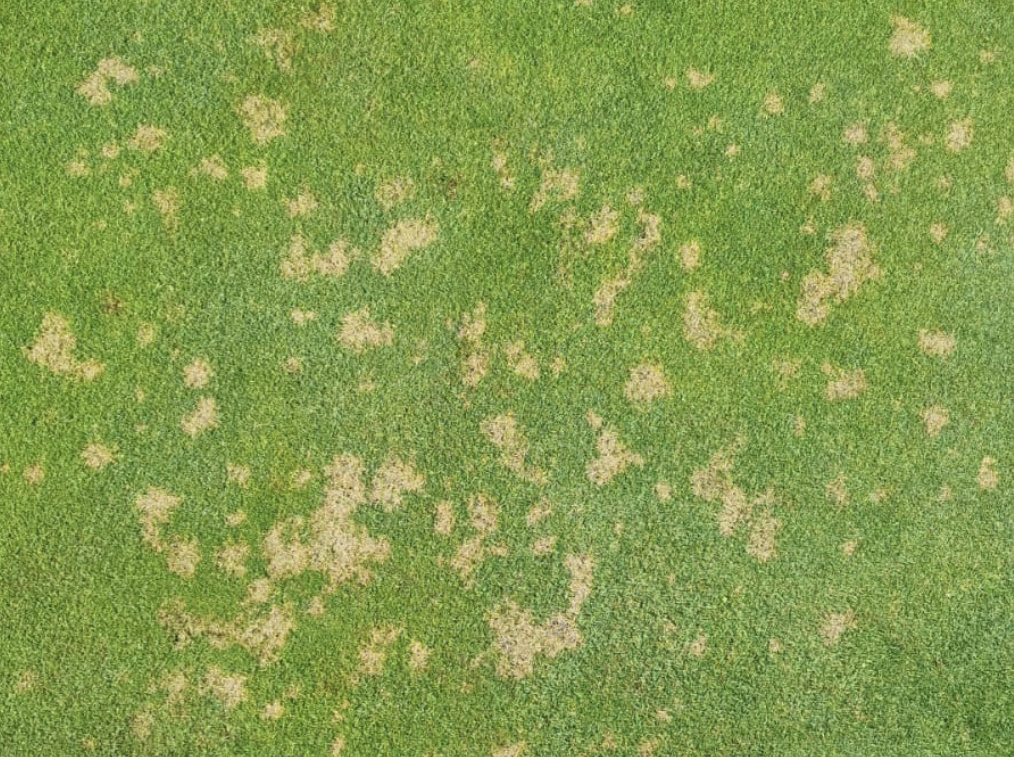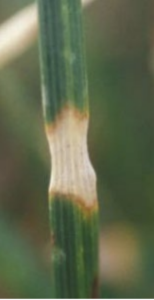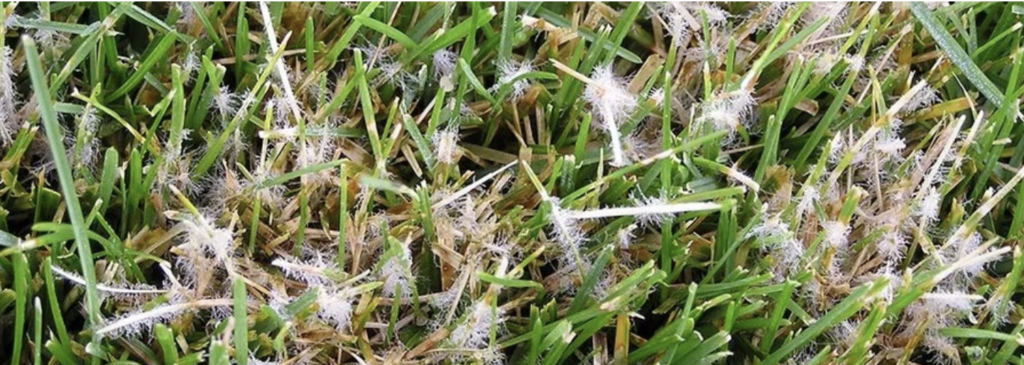The emergence of Dollar Spot as a significant turf disease in the UK is a relatively recent phenomenon, largely attributed to climate change. Historically, Dollar Spot was more prevalent in North America, but changes in weather patterns have facilitated its increased success here, posing new challenges for UK greenkeepers.
The Influence of Climate Change
- Rising Temperatures: The UK has experienced an increase in average temperatures over the past few decades. According to the UK Met Office, temperatures have risen by about 1°C since the mid-20th century. Dollar Spot thrives in warm temperatures ranging from 15°C to 30°C, and the warmer summers provide ideal conditions for the fungus to flourish (SpringerLink).
- Increased Humidity: Alongside rising temperatures, there has been an increase in humidity levels, especially during the summer months. The fungus Clarireedia jacksonii, responsible for Dollar Spot, requires high humidity and prolonged leaf wetness to establish and spread. Climate change has led to more frequent dew formation and wetter conditions, which are conducive to Dollar Spot development (Penn State Extension) (ASHS).
- Extended Growing Season: The UK’s growing season has been extended by about a month in recent decades. This prolonged period of grass growth increases the window of vulnerability to Dollar Spot, allowing the fungus to persist longer and potentially cause more damage (SpringerLink).
- Management Problems: Any suggestion of increased fungicide use of course brings up the discussion of whether or not bowling greenkeepers are qualified or certificated to apply restricted products or even to make decisions on their use, so it is important to keep this in mind when developing a programme at your particular facility.
Challenges for Greenkeepers
The increased incidence of Dollar Spot in the UK brings several challenges for greenkeepers who are now facing a disease that was previously uncommon:
- Increased Disease Pressure: With more favourable conditions for the fungus, greenkeepers must remain vigilant and proactive in their management practices to prevent outbreaks.
- Adaptation of Management Practices: Traditional UK turf management practices may need to be adjusted. For example, fungicide regimes may need to be adapted to include treatments specifically targeting Dollar Spot, and cultural practices such as dew removal and nitrogen management may require more attention (Penn State Extension).
- Economic Impact: The need for increased fungicide applications and more intensive turf management practices can lead to higher maintenance costs. The Golf Course Superintendents Association of America (GCSAA) notes that Dollar Spot is one of the most expensive diseases to control due to the frequent fungicide applications required for effective management (ASHS).
Dollar Spot’s increasing prevalence in the UK due to climate change highlights the broader impact of global warming on plant diseases. As conditions become more favourable for this and other pathogens, greenkeepers must stay informed and adapt their management strategies to maintain healthy and disease-free turf. By understanding the environmental factors driving the spread of Dollar Spot, the UK turf industry can better prepare for and respond to this evolving challenge.
By adapting to these new challenges and employing integrated pest management strategies, the UK’s turf industry can continue to provide high-quality playing surfaces while minimising the impact of climate-induced diseases like Dollar Spot.
Identifying Dollar Spot
Dollar Spot is one of the most common and troublesome turfgrass diseases affecting golf courses, bowling greens, and home lawns. This disease, caused by the fungus Clarireedia spp., is particularly notorious for affecting high-maintenance, closely-mown turfgrass like that found on putting greens and bowling greens. For amateur greenkeepers, understanding how to identify, prevent, and manage Dollar Spot is essential for maintaining healthy, high performance turf surfaces.

Recognising Dollar Spot is the first step in managing it effectively. The disease typically presents itself as small, circular patches of blighted grass, approximately the size of a US dollar coin, which is where it gets its name. These patches can coalesce into larger areas if left untreated. Key identifying features include:

Leaf Lesions: The most characteristic symptom is the appearance of lesions on grass blades. These lesions are usually straw-coloured with reddish-brown margins, giving them a distinctive “hourglass” shape (Penn State Extension) (ASHS).
Mycelium: Early in the morning, especially when dew is present, you may notice white, cobweb-like mycelium on the grass surface. This mycelium is a visible sign of the fungus actively growing and can be an important diagnostic feature (SpringerLink).
Grass Discolouration: Affected areas of turf appear sunken and are often lighter in colour than the surrounding healthy grass. As the disease progresses, the patches become more evident, especially in high humidity and during warm days with cool nights (Penn State Extension).
By understanding these symptoms, you can take proactive steps to manage and mitigate Dollar Spot outbreaks, ensuring your turf remains healthy and vibrant. Regular monitoring and maintenance practices, including proper mowing, watering, and fertilisation, play a crucial role in preventing this common turfgrass disease.
Physiology of the Organism
Dollar Spot is caused by the fungus Clarireedia jacksonii and closely related species. It primarily affects cool-season grasses such as bentgrass (Agrostis spp.), annual meadowgrass (Poa annua), and fine fescues (Festuca spp.).
- Mycelium: The fungus produces white, cobweb-like mycelium, typically visible in the early morning when dew is present.
- Infection Process: The fungus infects the leaf blades, causing small, round, bleached spots. Spots may coalesce into larger patches under severe conditions.
- Survival: The pathogen survives unfavourable conditions as dormant mycelium or as sclerotia, which are hardened fungal structures that can withstand extreme environmental stresses.
How Dollar Spot Spreads
- Sporulation and Dissemination: Although Clarireedia species can produce spores, the primary method of spread is through mycelial fragments. These fragments are disseminated by mowing equipment, water, foot traffic, and other mechanical means.
- Environmental Dissemination: The disease can spread rapidly under conditions favourable to fungal growth, especially during irrigation and natural rainfall which can splash infected mycelium onto adjacent leaves.
Environmental Conditions That Favour Dollar Spot
- Temperature and Humidity: Optimal conditions for Dollar Spot development are temperatures between 15°C and 30°C with high humidity or extended periods of leaf wetness.
- Dew Formation: Prolonged periods of dew or surface moisture, especially overnight, provide the moisture needed for mycelial growth and infection.
- Nutrient Deficiency: Nitrogen-deficient turf is particularly susceptible, as poor nutrition weakens the grass, making it more vulnerable to infection.
- Thatch and Soil Compaction: Excessive thatch and compacted soil can create a microenvironment that favours fungal growth by retaining excessive moisture at the green surface and reducing air circulation around plant crowns.
Cultural Practices to Deter Dollar Spot or Aid Grass Recovery
- Nutrient Management:
- Balanced Fertilisation: Maintaining adequate nitrogen levels is crucial. Regular monitoring of grass clipping yield is the most straightforward method for measuring this and monitoring the colour of the turf is also useful. Yellowing turf, coupled with low clipping yield in summer is often associated with Nitrogen Deficiency. This is especially true in wet summers, when Nitrogen leaches readily from sandy rootzones in periods of excessive rainfall.
- Mowing Practices:
- Mowing Height: Mowing at the recommended height for the specific grass species helps maintain plant health and resilience. Shaving grass plants too close for extended periods, puts them under stress. Root mass is directly correlated with leaf tissue mass. Excessively close mowing will reduce root mass and depth.
- Equipment Sanitation: Regular cleaning of mowing equipment reduces the risk of spreading the fungus.
- Light Rolling of Greens: Recent studies suggest that light rolling of greens can help reduce the severity of Dollar Spot. The mechanism at work here involves the physical disruption of dew and guttation fluids on the turf surface. These fluids provide a moisture-rich environment necessary for the fungal mycelium to thrive and infect the grass blades. By rolling the greens, the dew is removed, which reduces the period of leaf wetness and consequently the infection risk. Light rolling can also encourage tillering of new shoots, improving the recovery process from attack. When combined with proper mowing, fertilisation, and fungicide application, light rolling forms an effective part of an integrated disease management strategy.
- Water Management:
- Irrigation Scheduling: Watering should be done early in the day to allow the turf to dry before nightfall, reducing leaf wetness duration.
- Avoid Overwatering: Excessive irrigation creates conditions conducive to fungal growth.
- Thatch Management:
- Aeration and Verticutting: Regular aeration and verticutting reduce thatch buildup, improving air circulation and water infiltration.
- Biological Control:
- Biocontrol Agents: Research into biological control options, such as beneficial fungi and bacteria, is ongoing. These agents can suppress Clarireedia spp. through competition or direct antagonism.
- Environmental Manipulation:
- Microclimate Modification: Reducing shade and improving air movement around the turf canopy can lower humidity levels and dew formation, creating a less favourable environment for the fungus.
- Silicon: Applying Potsi at the early signs of a Dollar Spot attack can reduce the severity of the outbreak and minimise damage to plants.
Impact of Fungicides on Beneficial Soil Fungi
Fungicides are commonly used in turf management to control diseases like Dollar Spot. However, their use can have unintended consequences on the soil microbiome, including beneficial fungi. Understanding these impacts is crucial for developing integrated pest management (IPM) strategies that minimise harm to non-target organisms.
Broad-Spectrum Fungicides and Their Effects
Broad-spectrum fungicides, which are designed to target a wide range of fungal pathogens, can negatively impact beneficial soil fungi. These beneficial fungi play essential roles in soil health, plant nutrition, and disease suppression. Some common fungicides used for controlling Dollar Spot include:
- Propiconazole: A triazole fungicide that inhibits the synthesis of ergosterol, a key component of fungal cell membranes. While effective against Dollar Spot, it can also affect non-target fungi, including mycorrhizal fungi, which are crucial for plant nutrient uptake.
- Chlorothalonil: A broad-spectrum fungicide that disrupts cell metabolism in fungi. It is effective against various turf diseases but can also harm beneficial saprophytic fungi that decompose organic matter, affecting soil structure and fertility.
Specific Studies and Findings
- Impact on Mycorrhizal Fungi: Mycorrhizal fungi form symbiotic relationships with plant roots, enhancing nutrient and water uptake. Studies have shown that fungicides like propiconazole and chlorothalonil can reduce mycorrhizal colonisation, potentially impacting plant health and growth.
- Soil Biodiversity: A reduction in fungal biodiversity due to fungicide application can lead to a less resilient soil ecosystem, making it more susceptible to diseases and environmental stresses.
- Soil Enzyme Activity: Fungicides can alter soil enzyme activities, which are vital for nutrient cycling. For instance, propiconazole has been reported to decrease dehydrogenase activity, an enzyme involved in soil organic matter decomposition.
Integrated Pest Management (IPM) Strategies
To mitigate the adverse effects of fungicides on beneficial soil fungi, the following IPM strategies can be employed:
- Fungicide Rotation and Reduction: Rotating fungicides with different modes of action can help prevent resistance and reduce the impact on non-target organisms. Additionally, reducing fungicide application frequency and dosage can minimise harm.
- Biological Controls: Incorporating biological control agents, such as beneficial fungi and bacteria, can help suppress pathogens while promoting a healthy soil microbiome. Products containing Trichoderma spp. and other biocontrol agents are becoming more popular in sustainable turf management.
- Cultural Practices: Enhancing cultural practices, such as proper mowing, irrigation management, and aeration, can reduce disease pressure and reliance on fungicides. These practices help create an environment less conducive to pathogen development while supporting beneficial soil organisms.
While fungicides are effective in controlling Dollar Spot, their broad-spectrum nature can negatively impact beneficial soil fungi. Implementing IPM strategies that include fungicide rotation, biological controls, and improved cultural practices can help maintain soil health and reduce the negative impacts on non-target organisms.
Efficacy of Trichoderma Fungi as a Biocontrol Agent Against Dollar Spot
Trichoderma species are well-known biological control agents (BCAs) used to combat various plant pathogens. Their effectiveness in controlling turf diseases, including Dollar Spot caused by Clarireedia spp., has been a subject of ongoing research. The following is an analysis of their potential benefits and mechanisms of action against Dollar Spot.
Mechanisms of Action
Trichoderma fungi employ several mechanisms to suppress plant pathogens, including:
- Mycoparasitism: Trichoderma spp. can directly parasitise the mycelium of pathogenic fungi. They coil around and penetrate the hyphae of the pathogen, leading to its destruction.
- Antibiosis: These fungi produce secondary metabolites with antifungal properties that inhibit the growth of pathogens. Compounds such as gliotoxin, viridin, and peptaibols are known for their antimicrobial activity.
- Competition: Trichoderma spp. compete with pathogens for nutrients and space, effectively outcompeting them and preventing their establishment.
- Induced Systemic Resistance (ISR): Trichoderma can enhance the plant’s own defence mechanisms, making it more resistant to subsequent pathogen attacks.
Research Findings
Several studies have demonstrated the potential of Trichoderma species in controlling Dollar Spot:
- In Vitro Studies: Laboratory experiments have shown that Trichoderma spp. can inhibit the growth of Clarireedia spp. through direct antagonism and production of antifungal compounds.
- Field Trials: Field trials on golf course greens have indicated that applications of Trichoderma formulations can reduce the severity of Dollar Spot. For instance, research published in the journal Plant Disease reported a significant decrease in disease incidence when Trichoderma spp. were applied as part of an integrated management programme.
Application Methods
- Soil Drench: Applying Trichoderma as a soil drench can help establish the fungus in the rhizosphere, where it can compete with and suppress soil-borne pathogens.
- Foliar Spray: Foliar applications can directly target the pathogen on leaf surfaces, although persistence and effectiveness can be influenced by environmental conditions.
BioTabs are a good source of Trichoderma for this purpose or you can use the Fungal Additive to add it to your compost tea brews.
Benefits and Considerations
- Environmental Safety: Trichoderma spp. are generally considered safe for the environment and non-target organisms, making them an attractive alternative to chemical fungicides.
- Resistance Management: Using Trichoderma in conjunction with chemical controls can help mitigate the risk of pathogen resistance to fungicides.
- Synergistic Effects: Combining Trichoderma with other biological agents or reduced rates of chemical fungicides can enhance overall disease control efficacy.
Trichoderma fungi have shown promise as biocontrol agents against Dollar Spot, leveraging multiple mechanisms to suppress the pathogen and enhance plant health. Their use as part of an integrated pest management strategy can reduce reliance on chemical fungicides and promote sustainable turf management practices.
Incorporating Trichoderma into turf management can be an effective strategy to control Dollar Spot while maintaining environmental sustainability and soil health.
Conclusion
Managing Dollar Spot effectively requires a comprehensive understanding of the disease, its symptoms, and the various control methods available. By recognising the characteristic signs of Dollar Spot, such as small, circular patches of discoloured turf and straw-coloured lesions with reddish-brown margins, greenkeepers can take timely action to prevent its spread (SpringerLink) (Penn State Extension).
Implementing a combination of cultural practices, such as proper mowing, irrigation management, and balanced fertilisation, can significantly reduce the risk of infection (Penn State Extension) (ASHS). Furthermore, integrating biological controls like Trichoderma fungi and responsible fungicide use into your turf management plan can help maintain a healthy and resilient turf ecosystem (SpringerLink) (ASHS).
Remember, consistent monitoring and adopting an integrated pest management approach are key to keeping Dollar Spot at bay and ensuring your greens remain lush and inviting. With careful attention and the right strategies, even amateur greenkeepers can achieve professional-level turf care results.
By employing these techniques and staying informed about the latest research and management strategies, you can effectively combat Dollar Spot and maintain the health and performance your bowling green.
References and Further Reading
- UK Met Office Climate Change Overview
- A new dollar spot disease of turfgrass caused by Clarireedia paspali
- Biology and Management of Dollar Spot
- Turfgrass Diseases: Dollar Spot (Causal fungus: Clarireedia jacksonii)
- The Role of Trichoderma in Biological Control of Turfgrass Diseases


Should we sweep the dew off before a cut